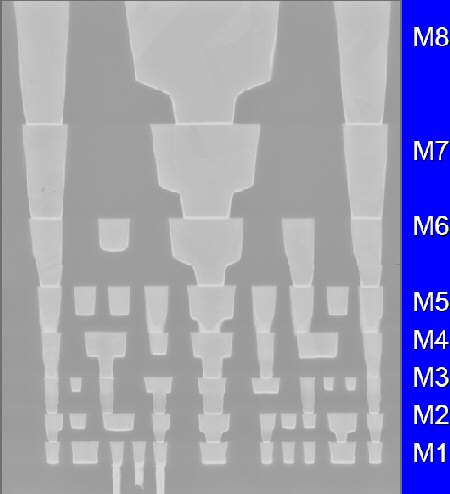The Quest for More Processing Power, Part One: "Is the single core CPU doomed?"
by Johan De Gelas on February 8, 2005 4:00 PM EST- Posted in
- CPUs
CHAPTER 3: Containing the epidemic problems
Reducing leakage
Leakage is such a huge problem that it could, in theory, make any advance in process technology useless. Without countermeasures, a 45 nm Pentium 4 would consume 100 to 150 Watts on leakage alone, and up to burn 250 Watts in total. The small die would go up in smoke before the ROM program would have finished the POST sequence.
However, smart researchers have found ways to reduce leakage significantly. SOI – Silicon on Insulator - improves the insulation of the gate and thus reduces leakage currents. SOI has made process technology even more complex, making it harder for AMD to get high binsplits on the Opteron and Athlon 64. However, it is clear that the Athlon 64 has a lot less trouble with leakage power than the Prescott, despite the fact that the Athlon 64 has only 20% less transistors than the Intel Prescott (106 versus 125 million).
The most spectacular reduction of leakage will probably come from Intel's "high-k" materials, which will replace the current silicon dioxide gate dielectric. Thanks to this advancement and other small improvements, Intel expects to reduce gate leakage by over one hundredfold! This new technology will be used when Intel moves to 45nm technology.
Another promising technique is Gate Bias technology. By using special sleep transistors, leakage can be reduced by up to 90% while the dynamic power is also reduced with 50% and more.
Body Bias techniques make it possible to control the voltage of a transistor. The objective is to make transistors slow (low leakage) when they are not used, and fast when they are. Stacked transistors and many other technologies also allow for reduction in leakage.[4]
One could probably write a book on this, but the message should be clear: the leakage problem is not going to stop progress. SOI already reduces the problem significantly and high K materials will make sure that the whole leakage problem will remain to be a nuisance, but not a major concern until the industry moves to even smaller structures than 45 nm.
At the same time, strained silicon will reduce the amount of dynamic power needed. With strained silicon, electrons experience less resistance. As a result, CPUs can get up to 35 percent faster without consuming more. This is what should allow the Athlon 64 stepping "E0" to reach higher clock speeds without consuming more.
Reducing Wire Delay
Although wire delay has not been so much in spotlight as leakage power, it is an important hurdle that designers have to take when they target high clock speeds. The resistance of wires has been reduced by both AMD and Intel using copper instead of aluminium. Capacitance has been lowered by using lower-K materials separating wires.

Fig 5. 8 Metal layers to reduce wire delay in Intel's 65 nm CPUs
Adding more metal layers is another strategy. More metal layers enable the wires connecting different parts of the CPU to be packed more densely. More densely means shorter wires. And shorter wires result in lower resistance, which, in turn, reduce the total RC Delay.

Fig 6. Repeaters on the Itanium Die
Of course, there are limits on what adding more metal layers, using SOI and lower-K materials can do to reduce RC delay. If some of the global wires are still too long, they are broken up into smaller parts, which are connected by repeaters. Repeaters can be used as much as you like, but they consume power of course.
Now that we have wire delay and leakage more or less out of control, let us try to find out what went exactly wrong with the Pentium 4 "Prescott". The answer is not as obvious as it seems.










65 Comments
View All Comments
stephenbrooks - Wednesday, February 9, 2005 - link
#28 - that's interesting. I was thinking myself just a few days ago "I wonder if those wires go the long way on a rectangular grid or do they go diagonally?" Looks like there's still room for improvement.Chuckles - Wednesday, February 9, 2005 - link
The word comes from Latin. "mono" meaning one, "lithic" meaning stone. So monolithic refers to the fact that it is a single cohesive unit.The reason you associate "lithic" with old is only due to the fact that anthropologists use Paleolithic and Neolithic to describe time periods in human history in the Stone Age. The words translate as "old stone" and "new stone" respectively.
I have seen plenty of monolithic benches around here. Heck, a slab granite countertop qualifies as a monolith.
theOracle - Wednesday, February 9, 2005 - link
Very good article - looks like a university paper with all the references etc! Looking forward to part two.Re "monolithic", granted the word doesn't mean old but anything '-lithic' instantly makes me think ancient (think neolithic etc). -lithic means a period in stone use by humans, and a monolith is a (usually ancient) stone monument; I think its fair to say Intel were trying to make the audience think 'old technology'.
DavidMcCraw - Wednesday, February 9, 2005 - link
Great article, but this isn't accurate:"Note the word "monolithic", a word with a rather pejorative meaning, which insinuates that the current single core CPUs are based on old technology."
Neither the dictionary nor technical meanings of monolithic imply 'old technology'. Rather, it simply refers to the fact that the single-core CPU being referred to is as large as the two smaller chips, but is in one part.
In the context of OS kernel architectures, the Linux kernel is a good example of monolithic technology... but I doubt many people consider it old tech!
IceWindius - Wednesday, February 9, 2005 - link
Even this articles makes my head hurt, so much about CPU's is hard to understand and grasp. I wish I kneow how those CPU engineers do this for a living.I wish someone like Arstechinca would make something really built ground up like CPU's for morons so I could start understanding this stuff better.
JohanAnandtech - Wednesday, February 9, 2005 - link
Jason and Anand have promised me (building some pressure ;-) a threaded comment system so I can answer more personally. Until then:1. Thanks for all the encouraging comments. It really gives a warm feeling to read them, and it is basically the most important motivation for writing more
2. Slashbin (27): Typo. just typed with a small period of insanity. Voltage of course, fixed
3. CSMR: the SPEC numbers of intel are artificially high, as they have been spending more and more time on aggressive compiler optimisations. All other benchmarks clearly show the slowdown.
CSMR - Tuesday, February 8, 2005 - link
Excellent article. Couple of odd things you might want to amend in chapter one: "CPUs run 40 to 60% faster each year" contradicts the previous discussion about slowed CPU speed increases. Also power formula explanation on the same page doesn't really make sense as pointed out by #27.Doormat - Tuesday, February 8, 2005 - link
Good article. The only real thing I wanted to bring up was something called the "X Consortium". I wrote a paper in my solid state circuit design class a few years ago. Basically instead of having all the interconnects within a chip laid out in a grid-like fashion, it allows them to be diagonal (and thus, a savings of, at most, 29% - for the math impaired it could be at most 1/sqrt(2)). Perhaps the tools arent there or its too patent encumbered. If interconnects are really an issue then they should move to this diagonal interconnect technology. I actually dont think they are a very pressing need right now - leakage current is the most pressing issue. The move to copper interconnects a while ago helped (increased conductivity over aluminum, smaller die sizes mean shorter distances to traverse, typically).It will be very interesting to see what IBM does with their Cell chips and SOI (and what clock speed AMD releases their next A64/Opteron chips at since they've teamed with IBM). If indeed these cell chips run at 4GHz and dont have leakage current issues then there is a good chance that issue is mostly remedied (for now at least).
slashbinslashbash - Tuesday, February 8, 2005 - link
" In other words, dissipated power is linear with the e ffective capacitance, activity and frequency. Power increases quadratically with frequency or clock speed." (Page 2)Typo there? Frequency can't be both linear and quadratic..... from the equation itself, it looks like voltage is quadratic. (assuming the V is voltage)
AnnoyedGrunt - Tuesday, February 8, 2005 - link
And of course I meant to refer to post 23 above.-D!